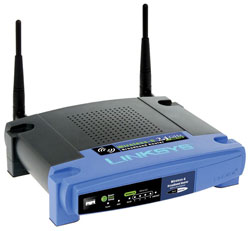Since moving into a place where my gaming den – more on that in an upcoming post – is beyond the reach of an ethernet cable, I came to require a way to get my 360 online wirelessly, and although the official adaptor was the obvious choice, I didn’t want to pay the frankly shameful £60 RRP. I know that wireless hardware is dirt cheap and that one isn’t even fully featured, lacking the WPA2 support that every certified Wi-Fi device since 2006 has featured. Not to mention that it wouldn’t help me avoid my previous issues with the PS3’s built-in Wi-Fi.
It’s not often that I can provide genuinely useful advice, so listen up. I know enough about home networking to know that one way around this is an ethernet bridge, which are reasonably cheap and will work with any ethernet device. But even so, buying one for each console and possibly more for, say, a standalone Blu-ray player in the future could add up.
 My solution was to buy a Linksys WRT54GL, which can be had for less than £50 new. It’s a fairly basic router with one exception: it runs on Linux.
My solution was to buy a Linksys WRT54GL, which can be had for less than £50 new. It’s a fairly basic router with one exception: it runs on Linux.
This being the Internet, it’s been taken apart by enthusiasts to add piles of features through third-party firmware. The free Tomato Firmware, which has a simple client mode as one of its key features, is exactly what you need. I put it in ethernet bridge mode and both consoles are online without a hitch, and the router has been going strong for two weeks now.
I should also point out that Tomato works with a number of other routers, which may even be cheaper. I just went with the Linksys because it was the original.
The official site has a video showing how to put it into client mode, which will be all that 99% of users want. There’s also an excellent tutorial here, which explains the difference between the two client modes – I went with bridge because I wanted everything on the same subnet for video streaming.
I know that I’m not the only one who is baffled by the fact that you can get an excellent router to do the job of the official adaptor and more for less money, but I’m not going to complain too much when open networking standards give us a relatively simple way around the problem. Alas, it’s not as easy to get around extortionate prices on other 360 peripherals like the larger hard drives or charging cables that cost comparatively nothing on a certain competing console, but maybe Microsoft will have a heart with the next iteration.
Then again, only one of those machines is actually making money. Maybe not…



